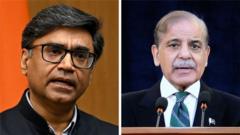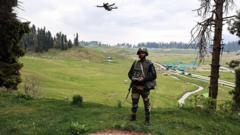In a dramatic escalation leading to significant military confrontation, President Trump confirmed a ceasefire between India and Pakistan following extensive talks aimed at de-escalating tensions. The conflict, marked by aerial attacks and drone warfare, raised international alarm as both nuclear-armed nations exchanged hostilities along the Line of Control in Kashmir. While U.S. officials took credit for mediating the agreement, both India and Pakistan emphasized direct negotiations for the ceasefire.
Trump Announces Ceasefire Between India and Pakistan Amid Renewed Conflict

Trump Announces Ceasefire Between India and Pakistan Amid Renewed Conflict
After four days of intense hostilities, President Trump mediates an agreement for a ceasefire between India and Pakistan, marking a pivotal moment in a longstanding conflict.
On May 10, 2025, President Trump took to Truth Social to announce a ceasefire agreement between India and Pakistan, concluding four days of extensive military engagement in Kashmir. The fighting, described by many analysts as the fiercest in decades, marked a new chapter in the nuclear-armed rivals’ historical conflict, with both countries leveraging drone technology in their military operations.
Indian and Pakistani officials quickly confirmed the ceasefire, although there were discrepancies regarding the extent of American involvement. Secretary of State Marco Rubio stated that they had engaged in shuttle diplomacy among the leaders of the two nations for over 48 hours, resulting in an agreement not only to halt hostilities but also to discuss broader issues at a neutral location. Contrarily, India’s foreign ministry reaffirmed that the ceasefire was reached directly between the two countries, downplaying the American role.
The military skirmishes began following a terrorist attack on April 22, which resulted in the deaths of 26 Indian tourists in Kashmir. India accused Pakistan of harboring the militants responsible and retaliated with airstrikes. This led to heavy engagements along the Line of Control, including the use of drones—an unprecedented tactic in this conflict, previously focused on traditional military strategies.
As a hopeful sign of de-escalation, Pakistan reopened its airspace, which had been closed due to the conflict, disrupting flights globally. International observers, including the European Union, welcomed the ceasefire announcement, urging both sides to respect it and pursue peaceful resolutions. The situation remains fragile, with ongoing tensions threatening to undermine the agreement.
Both countries are still grappling with deep-rooted hostilities and the aftermath of military actions, as they claim varying degrees of success in engagements over the past week. Analysts caution that while the ceasefire marks a significant step, its durability depends on further diplomacy and addressing core disputes over Kashmir, which has been a flashpoint for decades.
Indian and Pakistani officials quickly confirmed the ceasefire, although there were discrepancies regarding the extent of American involvement. Secretary of State Marco Rubio stated that they had engaged in shuttle diplomacy among the leaders of the two nations for over 48 hours, resulting in an agreement not only to halt hostilities but also to discuss broader issues at a neutral location. Contrarily, India’s foreign ministry reaffirmed that the ceasefire was reached directly between the two countries, downplaying the American role.
The military skirmishes began following a terrorist attack on April 22, which resulted in the deaths of 26 Indian tourists in Kashmir. India accused Pakistan of harboring the militants responsible and retaliated with airstrikes. This led to heavy engagements along the Line of Control, including the use of drones—an unprecedented tactic in this conflict, previously focused on traditional military strategies.
As a hopeful sign of de-escalation, Pakistan reopened its airspace, which had been closed due to the conflict, disrupting flights globally. International observers, including the European Union, welcomed the ceasefire announcement, urging both sides to respect it and pursue peaceful resolutions. The situation remains fragile, with ongoing tensions threatening to undermine the agreement.
Both countries are still grappling with deep-rooted hostilities and the aftermath of military actions, as they claim varying degrees of success in engagements over the past week. Analysts caution that while the ceasefire marks a significant step, its durability depends on further diplomacy and addressing core disputes over Kashmir, which has been a flashpoint for decades.























